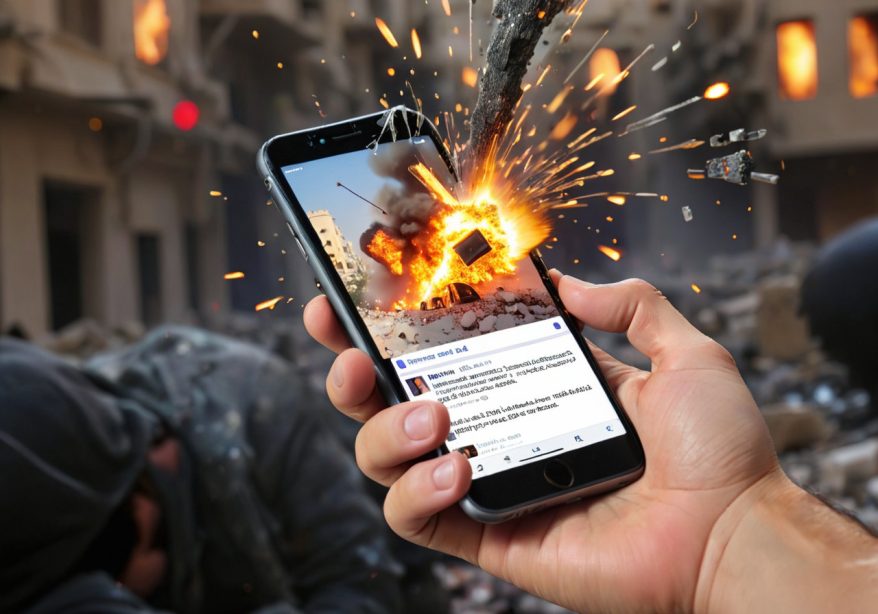You sit on the couch, phone in hand, scrolling through endless notifications. It’s hard to imagine life without this device—it’s your connection to the world, your guide through the chaos of modern life. But suddenly, it heats up. Too fast. Too hot. You drop it as smoke starts pouring from the screen. What happens next isn’t just your story; it’s the story of millions around the globe. Phones—everywhere—are exploding, sparking fires and chaos in homes, streets, and offices. This is no accident—it’s the result of a devastating cyber attack that has exploited a secret weakness in the world’s most popular phone brand.
Scenario Description:
In this chilling scenario, a massive cyber attack strikes, exploiting a planned obsolescence flaw hidden in a major phone brand’s hardware. For years, these devices have been programmed to degrade slowly, forcing users to upgrade every couple of years. But the flaw goes deeper than expected—so deep, in fact, that hackers discover they can remotely trigger an overload in the device’s battery management system, causing millions of phones worldwide to catastrophically overheat and catch fire.
The attack, orchestrated by an unknown rogue state or cyber-terrorist group, affects devices in every country, creating chaos on an unprecedented scale. People across the globe suffer as their phones explode without warning—at work, on public transportation, in their homes. Hundreds of thousands are injured by the blasts, and thousands lose their lives to the resulting fires, accidents, and explosions.

This isn’t the first time users have lost more than they bargained for from tech disasters. A historical example from the early days of the smartphone era adds a chilling context: in the transition from Android’s Jellybean OS to KitKat, many users lost access to their Bitcoin wallets because the OS upgrade wiped application data. People lost significant sums of money overnight, and even when users tried to restore their data using Asus PC Tool, they discovered the tool had only backed up photos and messages—no critical data, no applications. It was a stark reminder that even trusted systems could fail catastrophically.
Now, history is repeating itself on a much more destructive scale. The cyber attack exposes not just phones, but the fundamental dangers of relying on flawed technology and planned obsolescence.
The Unseen Threat of Planned Obsolescence:
For years, the phone brand at the heart of the disaster had used planned obsolescence to drive sales, quietly programming its devices to slow down and degrade over time. What users didn’t know was that this same practice left them vulnerable to the unthinkable. With a single line of malicious code, millions of phones became ticking time bombs. And now, the consequences are devastating.
Just as Asus PC Tool failed to protect vital data for users back in the early 2010s, tech companies have once again put users at risk—this time, with a far deadlier outcome. The digital world, once considered a source of convenience, has become a weapon that can turn on its users in the blink of an eye. The attack forces people to confront an uncomfortable reality: How much control do we really have over the devices we depend on? And what happens when those devices turn against us?
The Aftermath and Digital Detoxing:

As the fires rage and the bodies are counted, a new movement begins to take shape: digital detoxing. People begin to reject the culture of constant connectivity, realizing the risks of relying too heavily on technology that is fundamentally flawed. They seek to regain autonomy by disconnecting from their devices, choosing to focus on real-life interactions and experiences instead of living through their screens.
Governments and consumer advocates push for stricter regulations on tech companies, demanding transparency and accountability. The tech industry, shaken by the disaster, is forced to reevaluate its practices and eliminate planned obsolescence from future products.
Communities that once revolved around the latest phone model and social media trends start to shift toward sustainability and mindfulness. People begin to embrace older, more reliable technologies that don’t come with hidden risks. The global addiction to smartphones is challenged as users realize they no longer want to be at the mercy of companies willing to compromise their safety for profit.
Prevention and Mitigation:
Avoiding future disasters like the Digital Inferno requires a fundamental shift in how we approach technology. Digital detoxing becomes a key strategy for reducing dependence on vulnerable devices. By disconnecting from phones, tablets, and constant notifications, individuals can take control of their lives, free from the manipulative design practices of big tech.
Choosing products with long-term reliability instead of planned obsolescence is another essential step. Users begin to demand higher standards from tech companies, favoring brands that prioritize safety, longevity, and transparency over flashy marketing and frequent upgrades. Governments and regulators step in to ensure that products are built with user safety in mind, introducing new laws to prevent the kind of planned obsolescence that led to the Digital Inferno.

